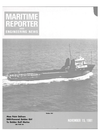
Report On Laser Technology Made To ASNE Long-Beach-Greater L.A. Section
The first meeting of the 1981- 82 year for the Long Beach- Greater Los Angeles Section of ASNE was held recently at the Los Alamitos Armed Forces Reserve Center Officers Club. Following dinner, Capt. J.A. Gildea, USN, chairman, welcomed the 57 members and guests.
Chairman Gildea next introduced the speaker for the evening, Capt. Alfred Skolnick, USN, whose topic was "Laser Development and Application to the U.S. Navy." Captain Skolnick is project manager of High Energy Lasers, P.M. 22, of the Naval Sea Systems Command.
Captain Skolniek's presentation covered the Navy's application of high-energy lasers. He reviewed the laser research and development programs of all of the branches of the military with a look at the manning effort and costs of each, rating the Air Force, Navy and Army in that order.
He interspersed his talk with color slides of some of the developmental work done at TRW's Mission Viejo facility and cited the lasers' ability to shoot down a towed missile that was only 6 inches in diameter and 6 feet long. He explained that the focused energy of the laser beam melted the outer dome cap of the missile and the molten metal shorted out the fuse, thus exploding the missile. He said that there is currently under development a laser which uses a chemical reaction to create a high-energy pulse that can be focused on a target by means of mirrors. Since the laser is used to burn or melt the metal of the target vehicle, the power of the laser beam must be increased as the thickness of the metal it is to attack increases.
On ships or other vehicles having plating in excess of half an inch, present lasers would merely burn off the paint and do little or no damage to the metal. Also, he pointed out, laser beams are attenuated by atmospheric conditions such as fog, rain, and clouds and thus have rather severe limitations in low altitude combat applications. However, he noted, laser beams in outer space or in upper atmosphere can be very effective since vacuum is very beneficial to laser beam range and intensity.
While much of the laser development is highly classified, Captain Skolnick said that the Russians are spending tremendous amounts of resources in research and development of the subject.
The U.S. Navy is currently building a test facility at White Sands Proving Grounds, New Mexico, to further research and d e v e l op laser techniques and applications.
Captain Skolniek's presentation of the unclassified elements of a very sophisticated area of current technology held the attention of the audience for almost an hour, and he further enlightened them in the ensuing question and answer session which followed.
Other stories from November 15, 1981 issue
Content
- Paceco Moves Headquarters To New Gulfport, Miss., Plant page: 9
- Adm. Harold E. Shear Sworn-ln As Maritime Administrator page: 9
- President Reagan And Sponsor Authenticate Keel Of 'Yorktown' At Ingalls page: 10
- Marathon Launches Jackup Penrod 86 At Brownsville Yard page: 10
- Halter Delivers New Offshore Express Supply Boat page: 10
- New Compact Oil Water Separator From Sigma —Literature Available page: 10
- Seward, Alaska To Build Large Shipping Facility page: 11
- Inland Marine Delivers Towboat M/V Mike Schmaeng To Pott Industries page: 12
- Top Executive Changes Announced By Marco page: 13
- $30-Million Order Signed By Hongkong United Dockyards Ltd. page: 14
- Westinghouse Credit, Seafirst Leasing Provide Equity In Four- Towboat, 81-Barge Transaction page: 14
- SACM Publishes Brochure On Marine Diesel Engines —Copies Available page: 16
- Approve Application For $22 Million Title XI For Towboat, 68 Barges page: 16
- Literature Available From Marland On Inverto® Oil/Water Separator page: 16
- Publish New Brochure On End Entry Ball Valves From Zidell Explorations page: 18
- Appoint David Daniels National Sales Manager At M&T Chemicals page: 18
- Study Notes Upsurge In Offshore Rig Orders —U.S. Yards In Lead page: 19
- HUDSHIP Delivers The M/V Charles Haun To Parker Towing Company page: 19
- Chemical Waste Incinerator Ships Discussed At SNAME Chesapeake Section page: 19
- Port Of Portland Appoints European Representative page: 20
- Indonesia To Use Jetfoil In Naval, Commercial Roles page: 20
- Northern Radio Announces New HF/SSB Transceiver- Literature Available page: 21
- Mobile Workover Unit Houtech II Christened At Beth Steel's Beaumont Yard page: 21
- Christen Jackup J. Storm XVII At Bethlehem Steel's Beaumont Yard page: 22
- Mississippi Marine Delivers M/V Redneck—Second Of Three Towboats For Captain Hollinger page: 22
- $11.8-Million Navy Contract Awarded General Ship For Overhaul Of USS Vulcan page: 23
- Ohio River Officials Meet With Representatives Of Finnish Coal Interests page: 25
- Butterworth To Exhibit At Marintec China '81 page: 25
- Form New Repair Company To Service Mexican Gulf -Information Available page: 27
- NASSCO Delivers 'S/S Coast Range'— Second Of Three Carlsbad Class For Union page: 27
- Monark Boat Delivers Oil Recovery Vessel For Use On Lake Maracaibo page: 28
- Moss Point Marine Delivers Two Supply Vessels To Golden Gulf page: 28
- Imperial Oil Planning Semisub Drilling Rig With 6,000-Foot Capability page: 29
- Canadian Survey Shows 400 New Vessels Needed During Next Ten Years page: 34
- Santander Shipyard To Increase Drydock Capacity To 25,000-Dwt page: 34
- M. Rosenblatt Promotes Three To Company Officers page: 36
- Capt. Chao Awarded Medal Of Honor By St. John's University page: 37
- UPSCO Launches Hull Number 001 — A 120-Foot Tug For An ITB page: 38
- SNAME-Hawaii Discusses High-Speed Catamaran Hydrofoils page: 38
- Four New Branch Managers Appointed At M. Rosenblatt page: 53
- Report On Laser Technology Made To ASNE Long-Beach-Greater L.A. Section page: 58

